Emotional intelligence (EI) refers to our ability to understand, respond to, and manage our own emotions, as well as those of others. Empathy, a key component of EI, significantly influences our relationships with friends, family members, and colleagues. While not innate, empathy is a skill that can be learned and refined over time, particularly during childhood.
In this comprehensive guide, we explore the significance of teaching empathy to kids, examine key milestones in empathy development, and offer well-founded strategies for teaching children empathy. By incorporating these techniques, caregivers can empower children to become compassionate and empathetic individuals who positively contribute to their communities and the world.
The Importance of Teaching Empathy to Kids
As parents, teachers, and mentors, it’s crucial to understand how to teach empathy to children early on. Research from The National Library of Medicine stresses its importance, showing how lacking empathy can lead to social challenges. Researchers at Stanford agree that empathy has three key parts: feeling others’ emotions, understanding them, and showing compassion.
But is it necessary to start so early? As it turns out, childhood is where empathy grows best. By teaching kids empathy from a young age, we give them the tools they need to navigate relationships. Here are some fantastic ways that children can benefit from developing empathy at an early age:
- Building stronger connections: Empathetic children have a natural knack for connecting with others on a deeper level and forging meaningful relationships with peers, family members, and their broader community. By understanding and empathizing with others’ emotions, they cultivate bonds built on trust, mutual respect, and understanding.
- Developing conflict resolution skills: Empathy equips children with the ability to resolve conflicts peacefully. By empathizing with others’ perspectives, children can better negotiate disagreements and find solutions that satisfy all parties involved. This fosters a cooperative and harmonious environment where conflicts are approached with empathy and understanding.
- Cultivating emotional regulation: Understanding others’ emotions not only enhances children’s interpersonal skills but also aids in managing their own feelings. Empathetic children learn to recognize and regulate their emotions more effectively, enabling them to respond to others with kindness and empathy even in challenging situations.
- Promoting kindness and care: Teaching empathy instills values of kindness and caring in children, helping them develop a sense of responsibility towards others and the world around them. Empathetic children are more inclined to engage in acts of kindness, contributing to a more compassionate and inclusive society.
- Preventing bullying: Empathetic children are less likely to engage in bullying behavior. By understanding and empathizing with others’ experiences, they develop greater empathy towards those who may be vulnerable or different from themselves. This helps create a safer, more inclusive environment where bullying is less prevalent.
Empathy Development Milestones
 Understanding and demonstrating empathy is a developmental process influenced by various social-emotional skills. Key milestones in empathy development include:
Understanding and demonstrating empathy is a developmental process influenced by various social-emotional skills. Key milestones in empathy development include:
- Establishing secure, loving relationships: Strong bonds with caregivers provide the foundation for empathetic understanding and connection with others.
- Social referencing: Babies begin to observe and interpret caregivers’ reactions to people and situations, influencing their own responses and understanding of the world.
- Theory of mind: Toddlers develop an awareness that others have thoughts, feelings, and perspectives different from their own, laying the groundwork for empathy and perspective-taking.
- Self-recognition: Recognition of oneself in a mirror signifies a child’s understanding of themselves as separate individuals contributing to empathy development.
How to Teach Your Child Empathy with 12 Helpful Strategies
How do you teach empathy to young children? Here are some practical strategies for teaching empathy to kids of all ages:
1. Be the Role Model
Children learn by example, so strive to demonstrate empathy in your own interactions. Whether showing kindness to a stranger or understanding a friend’s perspective, your actions speak louder than words.
For example, if you witness someone struggling with groceries, offer to help them carry the bags, showing your child the importance of helping others in need.
2. Use Storytelling
Stories have the power to convey important lessons in a way that resonates with children. Share tales that highlight empathy, kindness, and understanding, inspiring your child to emulate these qualities in their own lives.
You could read a story about a character who goes out of their way to help a neighbor in need, demonstrating empathy and compassion. Afterward, you might discuss with your child how the character’s actions made a positive impact and how they can apply similar principles in their own lives.
 3. Ask, Listen, Learn
3. Ask, Listen, Learn
If you’re wondering how to teach a child empathy with communication skills, it’s essential to create an environment where open communication is encouraged. Take the time to ask your child about their thoughts, feelings, and experiences, and truly listen to what they have to say. This not only strengthens your bond but also teaches them the importance of empathy and active listening.
4. Encourage Different Perspectives
Prompt discussions that explore diverse viewpoints and experiences. By encouraging your child to consider different perspectives, you broaden their understanding of the world and cultivate empathy towards others.
While watching a movie or reading a book together, discuss how different characters might be feeling in certain situations, helping your child develop empathy for both fictional characters and real people.
5. Create a Caring Environment
Although people often discuss how to develop empathy in a child in a school setting, it’s important to first lay the foundation of empathy for children in the home.
Foster a nurturing environment at home and in social settings, where empathy and kindness are not only valued but actively practiced. Lead by example and encourage empathy in all aspects of daily life.
6. Practice Active Listening
Teach your child the skill of active listening — the ability to fully focus, understand, respond, and remember what is being said. By practicing active listening, they will learn to empathize with others and validate their feelings.
When your child comes to you with a problem or concern, give them your full attention, maintain eye contact, and respond empathetically, saying things like, “I understand why you feel that way.”
7. Teach to Give Back
Engage in acts of kindness, volunteer work, and community service together as a family. Whether it’s volunteering at a local shelter or helping a neighbor in need, these experiences instill values of empathy, compassion, and generosity in your child.
Consider spending a Saturday morning volunteering at a soup kitchen, serving meals to unhoused people. As you work alongside your child, you can discuss the importance of empathy and how small actions can make a powerful difference in someone’s life.
8. Discuss Real-Life Examples
Use real-life examples and experiences to illustrate empathetic behavior and its impact on others. By reflecting on these instances, your child learns valuable lessons about empathy and its importance in fostering positive relationships.
If you notice a friend comforting another friend who fell down and hurt themselves at the playground, you could use this example during a conversation with your child. You might say, “Did you see how Sarah helped Emily when she fell down? That was really kind and empathetic of her. Emily felt much better because Sarah showed that she cared. How do you think you could show empathy in a similar situation?”
 9. Encourage Expression of Emotions
9. Encourage Expression of Emotions
Create a safe space for your child to express their emotions openly and without judgment. By validating their feelings, you teach them empathy towards themselves and others. If they’re feeling sad or upset, let them know it’s okay to cry or talk about their feelings, reinforcing the importance of empathy towards themselves and others.
10. Validate Their Feelings
Acknowledge and validate your child’s feelings, demonstrating empathy and understanding in your responses. This helps them feel heard and valued, strengthening their ability to empathize with others.
If your child expresses frustration about being unable to understand a difficult homework assignment, you might say, “I understand that you’re feeling frustrated right now. It can be really tough when things don’t go as planned. Let’s work on it together and figure out a solution.” By acknowledging their emotions and offering support, you show your child that their feelings are valid and worthy of attention.
11. Teach Gratitude
Cultivate gratitude by encouraging your child to appreciate the kindness and support they receive from others. By fostering gratefulness, you nurture empathy and appreciation for the experiences and perspectives of others. Prompt them to write thank-you notes or express gratitude verbally, reinforcing empathy and appreciation for the experiences and perspectives of others.
12. Use Positive Reinforcement
Finally, if you want to understand how to teach kids empathy you must recognize the importance of acknowledging and praising empathetic behavior whenever you see it.
If you notice your child comforting an upset classmate, take a moment to express your appreciation for their kindness. You might say, “I’m really proud of your empathy towards your friend today. It’s wonderful to see you caring for others and making a difference in their lives.” By highlighting specific instances of empathetic behavior and offering genuine praise, you reinforce the value of empathy and inspire your child to continue demonstrating compassion in their interactions.
Find an Au Pair with Go Au Pair
Teaching kids empathy is essential to their development and well-being, as is finding childcare you feel good about. At Go Au Pair, we offer a unique and reliable solution for families seeking dedicated childcare assistance. With our comprehensive services and commitment to matching families with qualified Au Pairs, we ensure peace of mind and cultural enrichment for both hosts and their children.
Whether you’re looking for a compassionate caregiver to join your family or seeking a valuable cultural exchange experience, we have you covered. Explore our offerings today and find the perfect Au Pair for your family’s needs. Learn about our host family requirements if you’re interested in welcoming an Au Pair into your home, and feel free to contact us with any additional questions!



 3. Ask, Listen, Learn
3. Ask, Listen, Learn 9. Encourage Expression of Emotions
9. Encourage Expression of Emotions